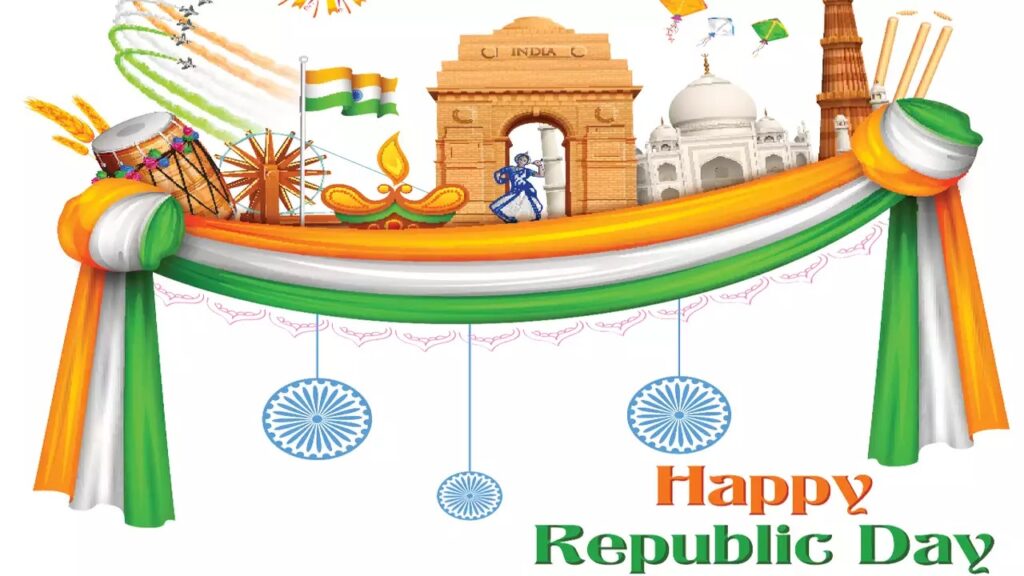
Republic Day in India is not just a national holiday; it is a vibrant celebration of the nation’s sovereignty and democratic values. Observed annually on January 26th, this day holds immense significance as it marks the adoption of the Constitution of India in 1950, replacing the Government of India Act (1935) and proclaiming India as a sovereign, socialist, secular, and democratic republic.
The celebrations unfold in a grand spectacle, vividly portraying the nation’s rich cultural diversity and nurturing a collective spirit among its people. The vibrant display encapsulates the essence of unity and pride, creating a memorable tribute to India’s heritage during Republic Day festivities.
Historical Significance: Republic Day
India Republic Day commemorates a historic moment in India’s journey towards independence. After gaining freedom from British rule in 1947, the country operated under the Government of India Act.
Nevertheless, the requirement for a comprehensive and sovereign constitution became apparent.
Dr. B.R. Ambedkar, the principal architect of the Indian Constitution, led the drafting committee, and on January 26, 1950, India officially adopted its Constitution.
Cultural Pageantry
India’s diverse cultural heritage is highlighted during India Republic Day celebrations, not confined to the military display. Various states and union territories participate in the parade, presenting a colorful tableau that reflects their unique traditions, art forms, and historical significance. The cultural pageantry adds a touch of artistic brilliance to the festivities.
Beating Retreat Ceremony
The celebrations extend beyond January 26, with the Beating Retreat Ceremony taking place on January 29. This ceremony, held at Vijay Chowk, involves performances by the bands of the Indian Army, Navy, and Air Force. The tunes played during the Beating Retreat hold historical significance, evoking a profound sense of national pride.
The India Republic Day Parade
The India Republic Day Parade in the capital city, New Delhi, is the centerpiece of the celebrations. The grand event unfolds on the iconic Rajpath, starting from Rashtrapati Bhavan (the Presidential Residence) and concluding at India Gate.
The parade showcases the nation’s military prowess, cultural heritage, and technological achievements. The President of India, as the Commander-in-Chief, takes the salute, and the entire nation witnesses the spectacular march-past.
Flag Hoisting and Celebrations Across the Nation
Republic Day is observed with great enthusiasm across the country. Flag hoisting ceremonies take place in schools, colleges, government offices, and public spaces. Patriotic songs are sung, and cultural programs are organized to instill a sense of pride and unity among citizens.
Historical Monuments Illumination
On India Republic Day evening, the collective spirit of the nation is symbolized by illuminating many historical monuments and landmarks. The illumination serves as a visual representation of the country’s commitment to democratic ideals and unity in diversity.
Awards and Recognitions
India Republic Day serves as a moment to honor individuals for their exceptional contributions to the nation.
The President of India confers the prestigious Padma Awards, including Padma Vibhushan, Padma Bhushan, and Padma Shri. These awards acknowledge excellence in diverse fields, including art, literature, science, public service, and sports
Republic Day Celebrations in Schools and Colleges
Educational institutions play a crucial role in instilling a sense of patriotism among students. India Republic Day celebrations in schools and colleges often include speeches, cultural programs, and debates that focus on the principles enshrined in the Indian Constitution.
These activities help students understand the importance of democracy, equality, and justice.
Challenges and Aspirations
India Republic Day, marked by celebrations, simultaneously serves as an occasion to reflect on the challenges the nation encounters. India Republic Day becomes an opportunity for citizens to renew their commitment to addressing these challenges and working towards a more inclusive and equitable society.
International Guests and Diplomacy
The customary inclusion of a chief guest, usually a foreign head of state or government, marks India Republic Day celebrations in India. This tradition symbolizes India’s commitment to international cooperation and diplomacy.
Stronger ties between nations are fostered as the invited guest witnesses the grandeur of the parade and cultural festivities.
Republic Day Quotes: Inspirational Words on Unity and Freedom
“India Republic Day celebrates the triumph of unity, diversity, and the spirit of democracy in our great nation.
“On India Republic Day, we honor the values that bind us as a nation and celebrate the strength of our diversity.”
“Let us remember the sacrifices of our forefathers and renew our commitment to the principles of justice, liberty, and equality.”
“India Republic Day is a reminder that our freedom and democracy are precious gifts that should never be taken for granted.”
“As we hoist the tricolor, let us pledge to uphold the ideals of our Constitution and work towards a brighter, inclusive future.”
“India Republic Day is a celebration of our shared heritage, a salute to our diversity, and a commitment to a united, progressive India.”
“Today, we celebrate the vision of a free, just, and sovereign nation, as enshrined in our Constitution on India Republic Day.”
“May the spirit of India Republic Day inspire us to be responsible citizens, contributing to the progress and well-being of our nation.”
“Our Constitution is the guiding light that illuminates the path of democracy, justice, and equality on India Republic Day and every day.”
“India Republic Day reminds us that the strength of a nation lies in its people, united in their diversity, upholding democratic values.”
Conclusion
India Republic Day in India is a testament to the country’s democratic values, cultural richness, and the collective spirit of its people. The celebrations serve as a reminder of the sacrifices made by the freedom fighters who envisioned an independent and democratic India.
As the tricolor flag waves proudly, and the national anthem resonates, India Republic Day becomes a moment for citizens to reflect on their roles in upholding the democratic ideals enshrined in the Constitution. It is a day to celebrate the unity in diversity that defines India and to renew the commitment to building a just, inclusive, and progressive nation.